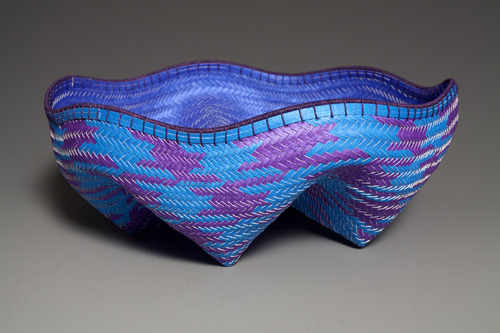
Basket weaving is an ancient tradition, but Dorothy McGuinness’s baskets are anything but traditional. Inspired by math, McGuinness’s work is untraditional both in form and in material. Dorothy is our LEAP Finalist for July, and her baskets will be for sale in our store until September 12th. Read on to learn more about Dorothy and her process:
SCC: Tell us about your work.
I create sculptural baskets using diagonal twill techniques. I use watercolor paper that I paint with acrylics and cut into strips using a pasta maker. Approaching my work as a puzzle drives me to discover new shapes and weaving innovations. I often think, ?How will it work out if I try this, or how can I get this shape or pattern combination? What if I use these colors in this combination in this order? What if??

SCC: Tell us about your training/education and any special mentors you have had
I have taken well over 200 basketry classes and workshops over the years from various local, national and international basket weavers and teachers. I took many if those at the Basketry School in the ?90s in Seattle and later at the Fishsticks Basketry School in Marysville, Washington. I?ve worked with willow, ash, cedar bark, white oak, birch and many other materials. I?ve explored coiling, twining, plaiting, mad weave, rib style baskets and everything in between. But, diagonal twills are what I enjoy working with the best.
I think Judy Zafforoni first exposed me to the idea of just playing in basketry. She was very good at letting students experiment with structure and form with her woven cherry bark baskets and folded pouches. Jiro Yonezawa, a Japanese basket maker and teacher was probably one of my greatest influences. I participate in over 30 workshops with him over the years. Working with Jiro taught me how to control the weaving process and an attention to detail, especially the finishing.

SCC: Why were you drawn to (type of medium you work in)?
I really liked weaving with bamboo with Jiro, but I knew I didn?t want to spend the years required to learn to prepare the bamboo properly for weaving fine baskets. So when I took the workshop on weaving with paper with Jackie Abrams I finally found my medium of choice. It worked great with my favorite technique, diagonal twills, I could play with color, there was no soaking of materials, and it was easily cut with a pasta maker and best of all I could just go to the store and buy my supplies.

SCC: What inspires you?
Lately math and geometry have been a great influence on my work. I have been working on a series based on platonic solids, which are 3D shapes where each face is the same size and the same numbers of faces meet at each corner. An example is a cube where each face is the same size square and 3 squares meet at each corner. I?ve also been working on some pieces based on the Pythagorean theory of a2 + b2 = c2.

SCC: What’s the best piece of advice you’ve received as a new artist?
The best advice I got early on, was to keep an idea journal. It?s a great way to be sure not to lose those ideas that come to you at odd times. Even if you have to write something down on a scrap of paper, you can add it to your journal be just by stapling it in.

SCC:?What advice do you have for others considering a career in the arts?
My advice is to keep learning new things and keep exploring until you find your own voice and vision.
You can see more baskets, and some mind blowing process photos on Dorothy’s website.
